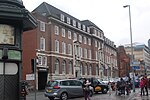Birmingham General Hospital
1779 establishments in EnglandBuildings and structures completed in 1779Defunct hospitals in EnglandHistory of Birmingham, West MidlandsHospital buildings completed in 1897 ... and 3 more
Hospital buildings completed in the 18th centuryHospitals in Birmingham, West MidlandsTeaching hospitals in England

Birmingham General Hospital was a teaching hospital in Birmingham, England, founded in 1779 and closed in the mid-1990s.
Excerpt from the Wikipedia article Birmingham General Hospital (License: CC BY-SA 3.0, Authors, Images).Birmingham General Hospital
Steelhouse Lane, Birmingham Digbeth
Geographical coordinates (GPS) Address Phone number Website Nearby Places Show on map
Geographical coordinates (GPS)
| Latitude | Longitude |
|---|---|
| N 52.48475 ° | E -1.8938888888889 ° |
Address
Birmingham Children's Hospital
Steelhouse Lane
B4 6NH Birmingham, Digbeth
England, United Kingdom
Open on Google Maps









